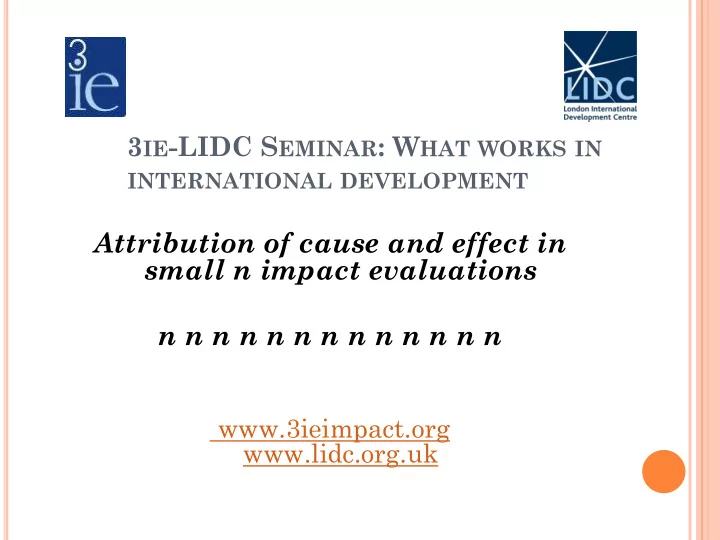

3 IE -LIDC S EMINAR : W HAT WORKS IN INTERNATIONAL DEVELOPMENT Attribution of cause and effect in small n impact evaluations n n n n n n n n n n n n n www.3ieimpact.org www.lidc.org.uk
Ie context matters Ie context matters S MALL n IMPACT EVALUATION Howard White and Daniel Phillips 3ie
All project- Outputs or affected persons D EFINITIONS I outcomes (PAPs) Impact evaluations answer the question as to what extent the intervention being evaluated altered the state of the world Intended All outcomes and and types of unintended outcome
D EFINITIONS II What is small n? Data on too few units of assignment to permit tests of statistical significance between treatment and a comparison group Why do you have small n? Small N Heterogeneity Budget NOT Universal or complex interventions
D EFINITIONS III Small n impact evaluation is Still about attribution, i.e. what difference did the intervention make? And so outcome monitoring alone is not enough About demonstrating a case „beyond reasonable doubt‟ of the link between intervention and change in the state of the work, which is more than „simple association‟, e.g. policy reform Includes tricky cases of declining counterfactual Difference between small and large n Large n establishes causation through statistical means Small n builds up case based on weight of evidence, strength of argument, and absence of other plausible explanations In mixed methods designs the large n component is the DNA evidence that can usually clinch the causal argument
T HE COUNTERFACTUAL Outcome Factual Counterfactual Time
We would have done it anyway
T HE COUNTERFACTUAL : WOULD HAVE HAPPENED ANYWAY Outcome Counterfactual Factual Time
T HE COUNTERFACTUAL II Outcome Factual Counterfactual Time
What is the counterfactual?
D EFINITIONS IV CONTRIBUTION VERSUS ATTRIBUTION Impact evaluation is defined as attribution Possible cases for wanting to use contribution instead: Multiple factors – but IE is meant to disentangle them, and attribution doesn‟t mean sole attribution Complementarities (two necessary conditions, and neither one sufficient, e.g. school feeding) – then state what they are Over-determination (two sufficient conditions, both present) – determine which is most cost effective e.g. WSS Complexity – then the black box may be a useful approach (remember Semmelweis) So contribution, which means same as attribution, because attribution analysis in IE seem to be limited, but these presumed limitations are mostly absent
W HEN SCHOOL FEEDING WORKS Understand context to look at sources of heterogeneity
H YGIENE AND SANITATION : SUBSTITUTES OR COMPLEMENTS ? Need a factorial design
S EMMELWEIS
A PPROACHES TO SMALL n IMPACT EVALUATION Explanatory approaches Contribution analysis, general elimination methodology, realist evaluation, process tracing Based around theory of change (causal chain) Explicit accounting for context and „other factors‟ Possibly generate testable hypotheses, to be tested using mixed methods Participatory approaches Method for Impact Assessment of Programs and Projects (MAPP), most significant change, success case method, outcome mapping Uses participatory data to analyze cause and effect (role programme has played in changes at community and individual level)
S O WHERE DOES THIS LEAVE US ? Common elements Clear statement of intervention Lay out theory of change, allowing for context and external factors (e.g. CCTV) Document each link in causal chain If things happened as planned, and intended outcome observed, then conclude causation (or not e.g. Peru microcredit) – using triangulation and other evidence e.g. Ghana hospital But the last step is getting a bit dodgy. Something is missing – what constitutes valid evidence of a link in the causal chain?
WHAT IS VALID CAUSAL EVIDENCE ? Want an approach which uncovers the „true causal relationship‟ in the study population (internal validity) In large n studies threats to internal validity can come from sampling error and selection bias Analogously, in small n studies bias arises if there is a systematic tendency to over or under- estimate the strength of the causal relationship
I S THERE SYSTEMATIC BIAS IN QUALITATIVE DATA COLLECTION AND ANALYSIS ? “There exist significant sources of “These biases arise bias in both the both in the collection and analysis responses given of qualitative data” and the way in which evaluators interpret these data” “These biases are likely to result in the systematic over-estimate of programme impact”
C OURTESY BIAS
P ERSPECTIVE DEPENDS ON WHERE YOU ARE STANDING
S ELF IMPORTANCE BIAS
The Barry Manilow t-shirt experiment
E XAMPLES Dating of policy reform Fundamental error of attribution: Missing actors or context, e.g. local policy environment People we don‟t speak to (trade unions, parliamentarians …..) Generally over-stating role of intervention e.g. DANIDA livelihoods The way in which evaluators interpret data reinforces the bias of respondents to overstate their role
S IMILAR PERSON AND EXPOSURE BIAS That‟s not how it Blah, was at all blah, blah blah, blah....
W HAT TO DO Well structured research with systematic analysis of qualitative data
Define intervention to be evaluated Identify Theory of evaluation change questions Identify mix of methods to answer each question Data collection and analysis plan
Recommend
More recommend